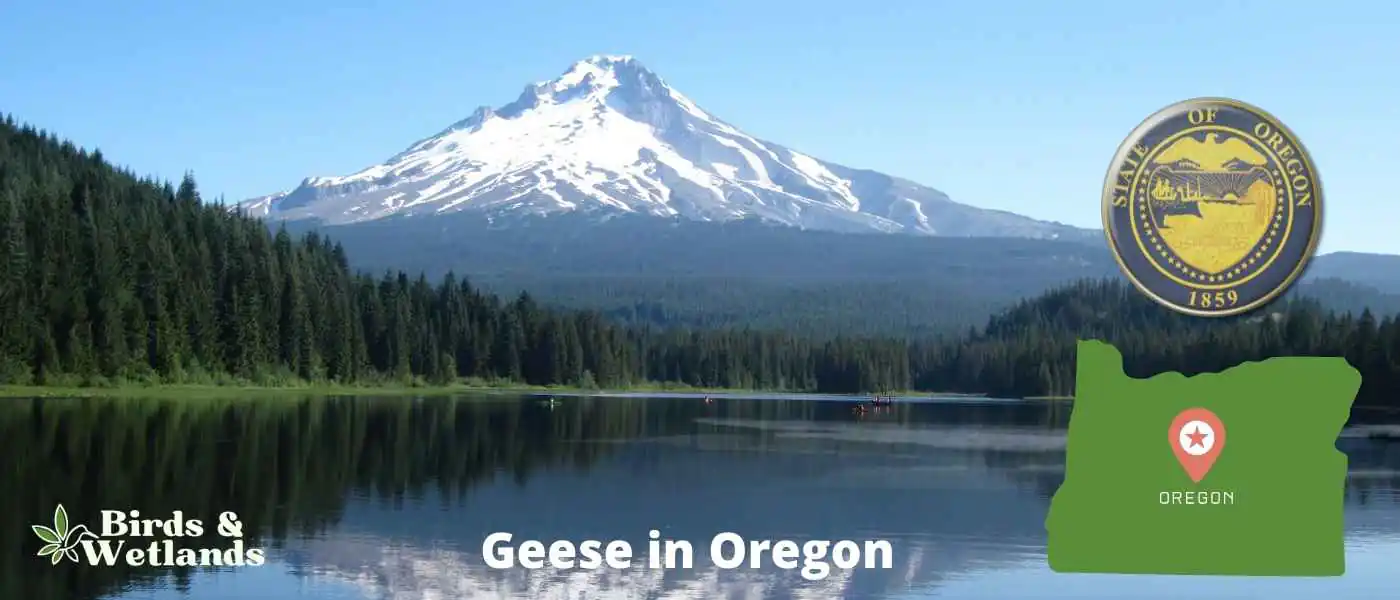Anyone who has spent time around Oregon’s waterways will know that there is an abundance of geese.
Geese can be found in every corner of the state, and they come in all shapes and sizes. There are several different types of geese that call Oregon home.
We take a closer look at some of the most common types of geese in Oregon. We will also discuss their habits and where you can find them.
What Geese Are in Oregon?
There are eight species of geese found in Oregon.
- Canada Goose
- Snow Goose
- Ross’s Goose
- Cackling Goose
- Greater White-Fronted Goose
- Emperor Goose
- Tundra Bean-Goose
There are also three species of swans in Oregon – Tundra Swans, Trumpeter Swans and Mute Swans.
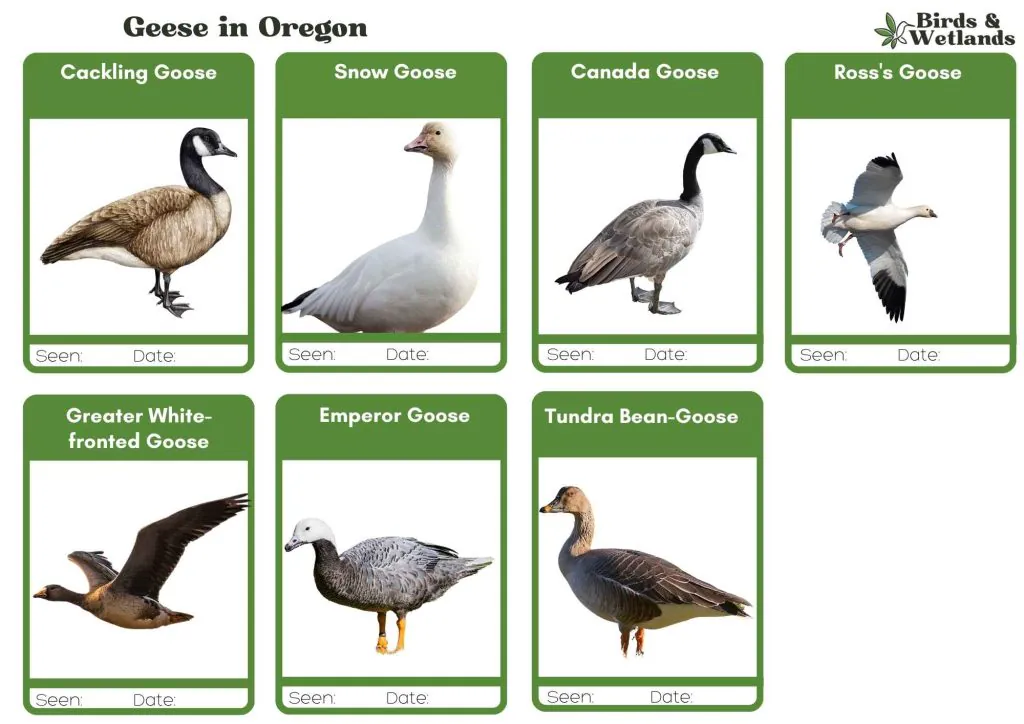
Canada Goose
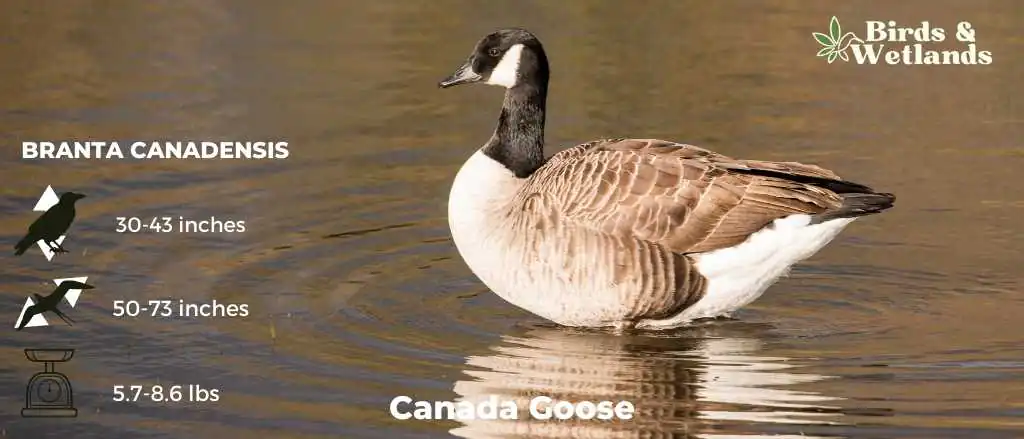

Canada Goose Sound
Scientific Name: Branta canadensis
Length: 30 to 43 in
Wingspan: 50–73 in
Weight: 5.7–14.3 lb
The Canada Goose is a large, well-known species of waterfowl noted for its distinctive appearance, familiar “honk,” and migratory behavior.
Appearance: Both male and female Canada Geese have a similar appearance, featuring a black head and neck with distinctive white patches on the cheeks and chin. The body is primarily brown with a lighter, often white, underbelly.
Diet: Canada Geese primarily feed on plant matter, including grasses, aquatic vegetation, and grains. They can often be seen grazing in parks, lawns, and fields, as well as dabbling in water bodies.
Reproduction: Canada Geese typically nest on the ground near water bodies, often on islands or other isolated areas to avoid predators. The female lays a clutch of about 4 to 6 eggs, which she incubates alone for around a month.
Snow Goose
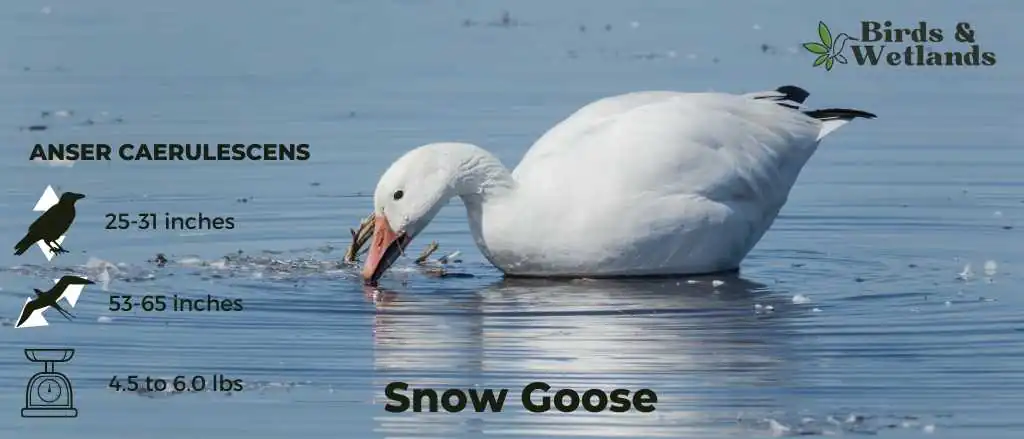
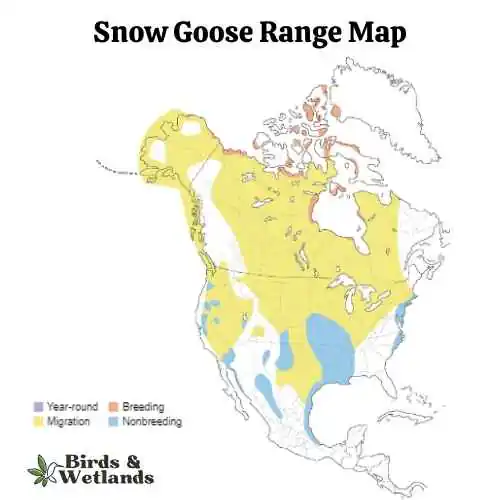
Snow Goose Sound
Scientific Name: Anser caerulescens
Length: 25 to 31 in
Wingspan: 53 to 65 in
Weight: 4.5 to 6.0
The Snow Goose is a large species of waterfowl known for its vibrant white plumage and significant migratory flights.
Appearance: True to their name, Snow Geese are predominantly white with black wingtips. They also have a pink bill, pink legs and feet. A color morph, known as the “Blue Goose,” displays a bluish-gray body with a white head, but is considered the same species.
Diet: Snow Geese primarily feed on plant matter, such as grasses, sedges, and small grains. They can often be seen in large flocks foraging in fields and marshes, and during migration and winter, they can cause considerable damage to agricultural fields due to their feeding habits.
Reproduction: Snow Geese typically nest on the tundra, near water bodies. The female builds the nest and lays a clutch of about 3 to 5 eggs, which she incubates alone for approximately three weeks. Once hatched, the goslings can feed themselves but stay with their parents for protection until they can fly.
Ross’s Goose
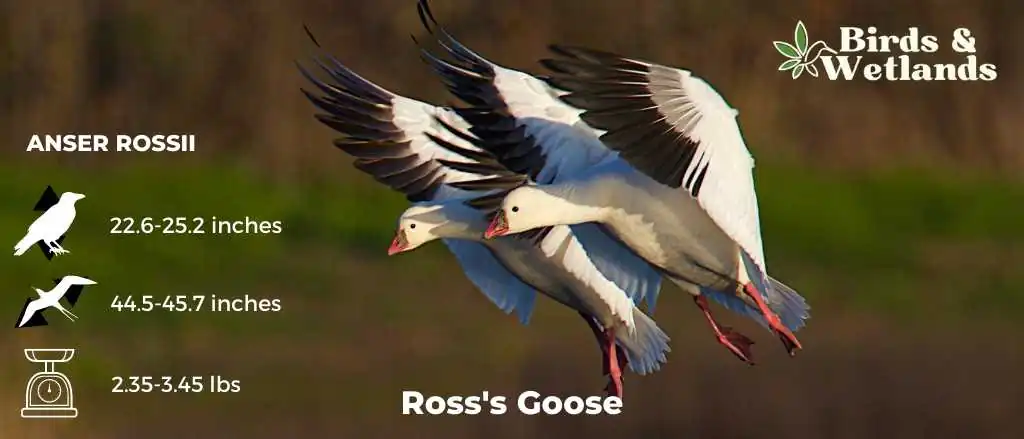
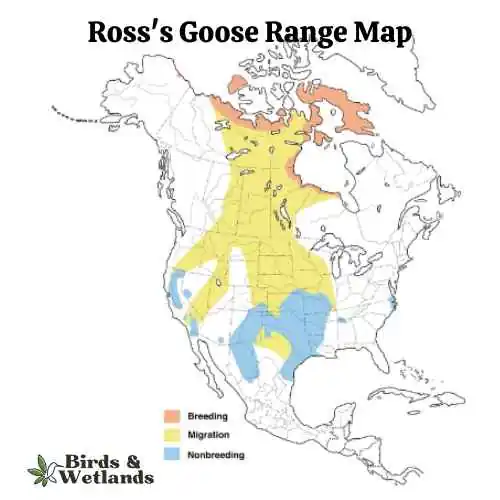
Listen
Scientific Name: Anser rossii
Length: 23.2-25.2
Wingspan: 44.5-45.7 in
Weight:42.3-55.3 oz
The Ross’s Goose is a small species of waterfowl often found in North America’s tundra and wetland habitats.
Appearance: Known for its compact size, the Ross’s Goose is mostly white with black wingtips. It features a short, stubby bill and a rounded head. One key identifying feature is the blueish gray base of its bill, which has a warty structure during the breeding season.
Diet: This goose feeds mainly on vegetation, including seeds, leaves, and roots of grasses and sedges. During winter and migration, they also consume grains and seeds from agricultural fields.
Reproduction: The Ross’s Goose nests on the ground, often in colonies. The female lays a clutch of 2 to 5 eggs which she incubates for around three weeks. The young geese, known as goslings, are precocial – they can walk, swim, and feed themselves shortly after hatching, although they stay with their parents until they learn to fly.
Cackling Goose
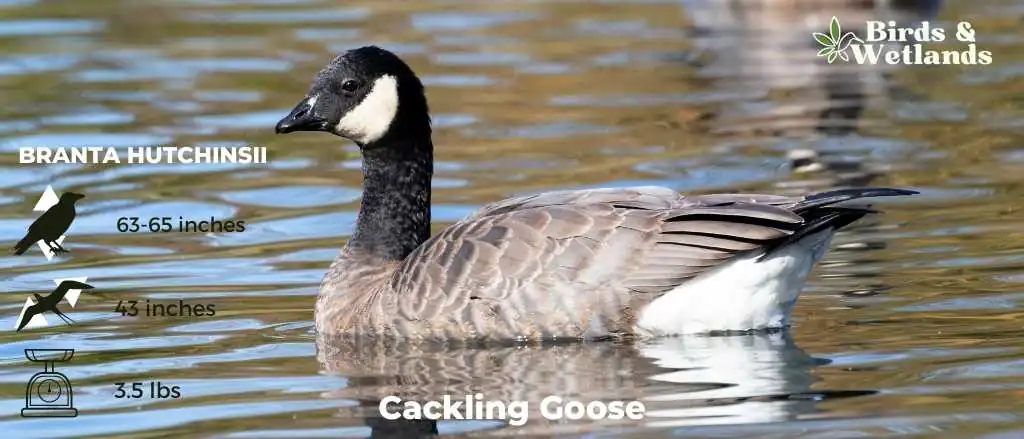
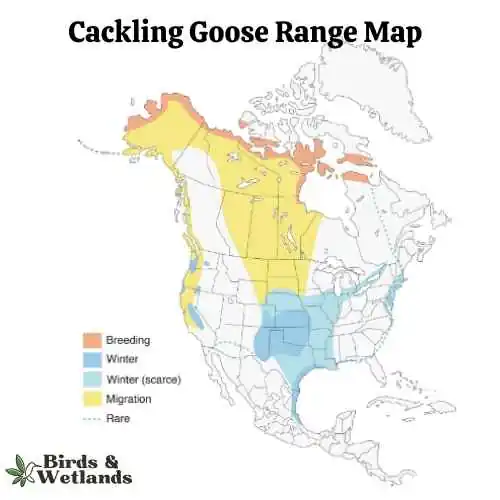
Listen
Scientific Name: Branta hutchinsii
Length: 24.8–25.6 in
Wingspan: 43-45.7 in
Weight:3.5 lbs
Cackling Geese are particularly known for their high-pitched, cackling calls, which is the source of their name. Despite their small size, these geese are renowned long-distance migrants, with some populations traveling thousands of miles between breeding and wintering grounds.
Appearance: With a similar color pattern to the larger Canada Goose, the Cackling Goose features a black head and neck, white chinstrap, light tan to cream chest, and brownish-grey body. One defining characteristic is its noticeably smaller size and stubbier neck compared to its larger counterparts.
Diet: Like many geese, the Cackling Goose’s diet mainly consists of plant matter. This includes grasses, seeds, and aquatic vegetation. They are often seen grazing on land or dabbling in shallow water.
Reproduction: Cackling Geese usually nest on the ground in elevated areas near water bodies, such as riverbanks or lakeshores. The female lays a clutch of 2 to 8 eggs and is responsible for incubation, while the male stands guard nearby. Incubation lasts for about a month.
Greater White-fronted Goose
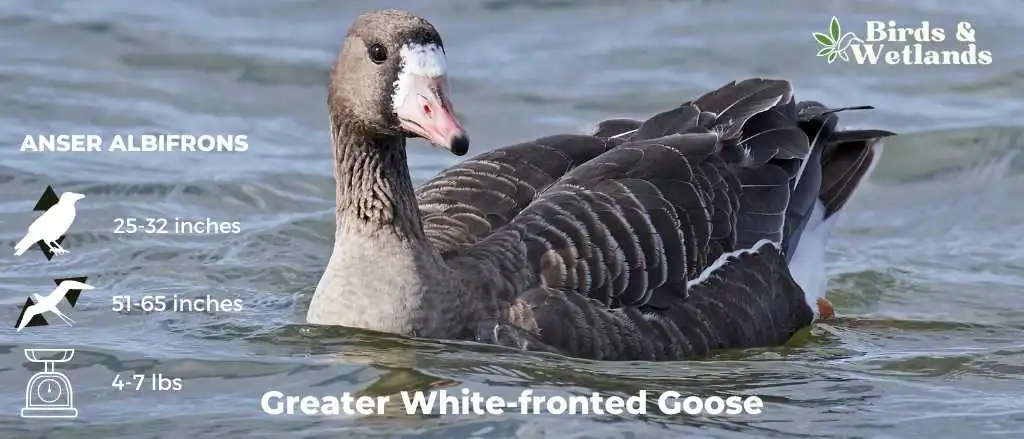

Listen
Scientific Name: Anser albifrons
Length: 25 to 31 in
Wingspan: 53 to 66 in
Weight: 3.3 to 6.6
The Greater White-fronted Goose is a medium to large waterfowl species, widely distributed across the Northern Hemisphere, particularly in North America.
Appearance: As the name suggests, these geese display a prominent white patch at the base of their bill. Their bodies are gray-brown, and their breasts are often marked with dark blotches. They possess a pinkish bill and orange legs and feet.
Diet: The Greater White-fronted Goose is a herbivore and feeds mainly on plant material. Its diet consists of grasses, sedges, grains, and berries. When wintering, these geese can often be found in agricultural fields, feasting on leftover grains and crops.
Reproduction: This species nests on the ground, often in areas with good visibility such as slopes or ridges. The female lays a clutch of 4 to 5 eggs, which she incubates for nearly a month. Once hatched, the young ones are taken care of by both parents until they are able to fly.
Emperor Goose
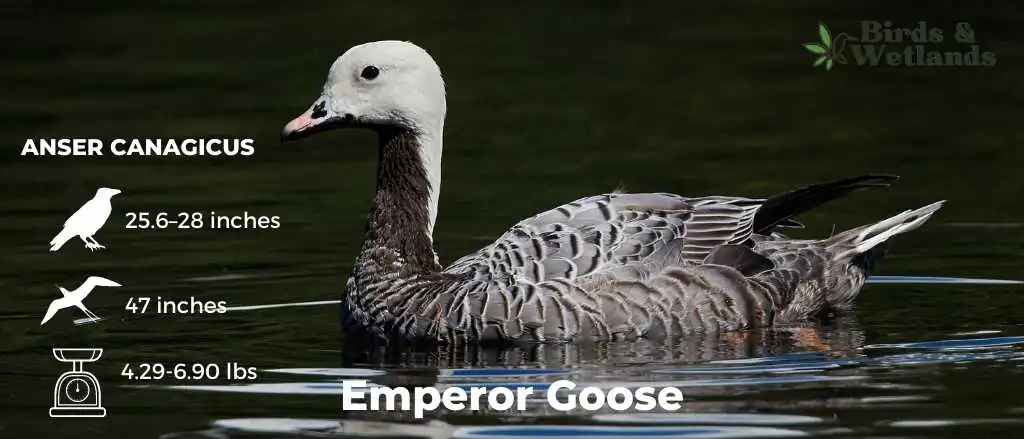
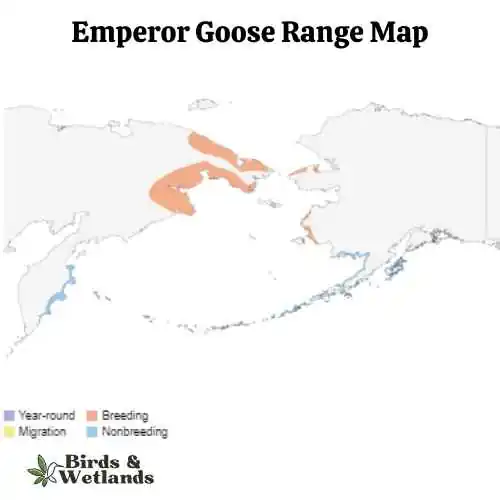
Listen:
Scientific Name: Anser canagicus
Length: 26–28 inches
Wingspan: 47 in
Weight: 4.29 lb
The Emperor Goose, also known as the beach goose or the painted goose, is one of the rarest geese in North America, and one that every birdwatcher hopes to see. This small and stocky goose is only found in Alaska. They are large birds with a wingspan of up to 4 feet and feed on the small plants in the mud at the edges of lakes and rivers, as well as roots and seeds.
The plumage is overall silvery gray, with a black and white margins making it look scaled. With a white head (which can become rust colored in the summer months), it has a black throat and its bill is small and pinkk, and the legs are orange. The sexes are similar, but juveniles have a duller plumage being gray all over.
Emperor geese need large tracts of land with patchy vegetation, water, and ample food to survive. Emperor geese use their bills to catch fish (and occasionally small mammals) while swimming in the water or flying over it. They thrive in wetland habitats because they provide the birds with food and protection from predators such as bears and wolves.
Female emperor geese lay 3-8 eggs per season in a nest made from grasses and plant material. She does the majority of incubation of the eggs, which take about 30 days to hatch.
Tundra Bean-Goose (Anser serrirostris)
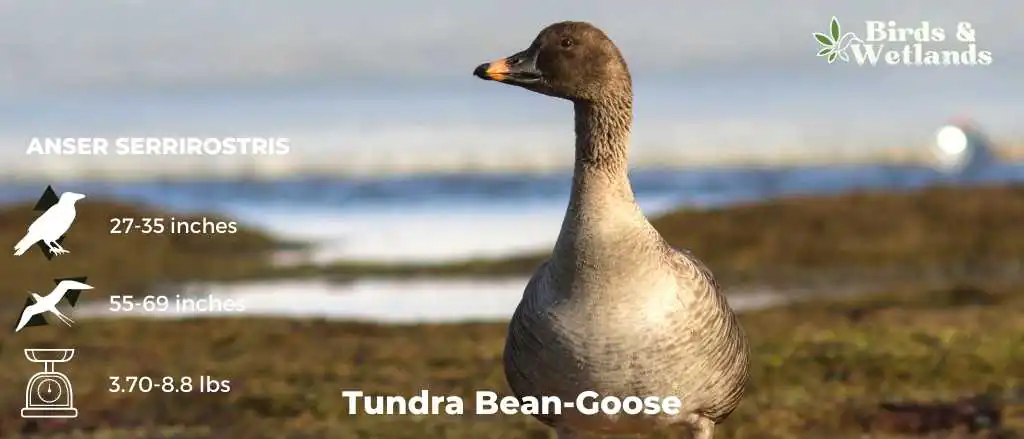
The Tundra Bean-goose is a beautiful, unique bird breed in northern Siberia. This bird is also called the Pink-footed Goose, despite having feet that are mostly black. This bird is also called the Pink-footed Goose, despite having feet that are mostly black.
- Scientific Name: Anser serrirostris
- Height: 68 to 90 cm (27–35 in)
- Wingspan: 140 to 174 cm (55–69 in)
- Weight: 1.7–4 kg (3.7–8.8 lb)
Tundra Bean-Goose Description
The Tundra Bean-Goose is a medium-sized goose with a black head and neck, white cheeks, and a creamy-white breast. It has black wings with white primary feathers on the inner edges. Its tail is black with cream-colored tips on the outer feathers. The legs are pinkish-brown, and its bill is bright red.
While this bird spends most of its time foraging for food, it will often fly into the air at speeds of up to 60 miles per hour when disturbed by humans or predators. It’s also one of the fastest birds in the world.
Tundra Bean-Goose Sound
Tundra Bean-Goose Habitat & Range
The Tundra Bean Goose breeds in North America, Greenland, and Iceland. They migrate southwards in winter to Europe, Africa, South Asia, and Australia. The populations from Canada and Alaska migrate south through the Rocky Mountains into California, Mexico, and Central America.
While once common throughout their range, the population has declined dramatically due to hunting and habitat destruction. The species is currently listed as endangered under the Endangered Species Act (ESA) if climate change continues to impact its habitat.
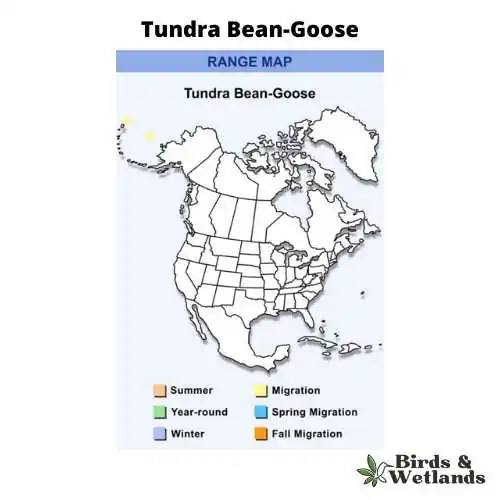
Tundra Bean-Goose Diet
They eat grass and sedges, which they find by probing the ground with their bills. Their diet also includes insects such as beetles or flies and larvae, grasses, and sedges found in the wetland areas where they live. They are monogamous and form lifelong bonds with their mates.
Tundra Bean-Goose Nesting
This bird uses open grassy areas for breeding but will also nest on tundra and coastal areas where there are no trees or shrubs nearby such as Arctic tundra (where it can be found during summer months) or glaciated regions such as Greenland (where it can be seen during winter).
Where to Watch Geese in OR?
Oregon is a great place to see geese, especially in the winter.
The majority of wintering snow geese in Oregon are found along the lower Columbia River between the mouth of the Willamette River and Astoria. This is a great place to see these birds because they are attracted to the open water and grassy areas that are found here.
Summer Lake Wildlife Area is another great place to see geese. This area is known for its large populations of breeding and migrating birds, including geese.
In addition to being a great place to see geese, Summer Lake Wildlife Area is also a beautiful place to visit with its crystalline lakes and lush landscapes.
Are There Any Resident Flocks of Geese In OR?
Resident Canada geese are found throughout the Willamette Valley and Sauvie Island in Oregon, as well as along the Oregon coast and in other native wetlands throughout the state.
They can also be found at several National Wildlife Refuges, including the Malheur National Wildlife Refuge and the Klamath Basin National Wildlife Refuge.
In addition, they often congregate at lakes, golf courses and ponds, where they can find food and safe places to rest.
While they are typically found in areas with water, they can also be seen in farmlands and grasslands, where they forage for food.
Geese Hunting in Oregon
In order to hunt geese in Oregon, hunters must have appropriate permits, stamps and licenses. A hunting license is required for all hunters and can be obtained from the Oregon Department of Fish and Wildlife.
Goose hunters in the Northwest Permit Zone must pass the Northwest Oregon Goose Test. Goose hunters must carry their Northwest Goose permit while hunting.
Can You Shoot a Goose in Oregon?
In Oregon, you can shoot geese with non-toxic shot approved by the U.S. Fish and Wildlife Service.
You can also use hunting methods that are allowed under federal regulations.
Hunting of waterfowl using lead shots is strictly prohibited. Oregon, like other states, has daily bag and possession limits on geese.
Where to Hunt Geese in OR?
Northwest Oregon, also known as the Northwest Oregon Permit Zone, is a great place to hunt geese.
The Willamette River Greenway, which runs through the region, is a perfect spot for box blinds and other hunting setups.
In addition, the Northwest Region is home to many different kinds of geese.
Is There a Goose Hunting Season in Oregon?
The goose hunting season in Oregon usually starts in October and runs through the middle to late January.
Conclusion on Geese in the State of Oregon
If you’re looking to see some of Oregon’s beautiful waterfowl, be sure to visit a park or wildlife refuge where you can find geese and swans.
There are plenty of locations throughout the state where you can catch sight of these graceful creatures.

